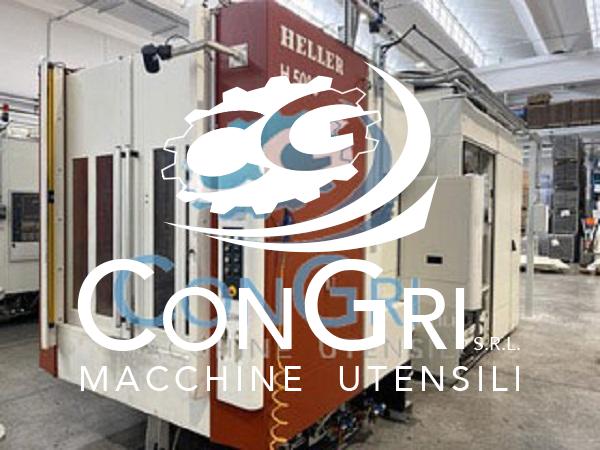Vertical and horizontal machining centers: criteria for an informed choice
Choosing between vertical and horizontal machining centers directly affects your workshop’s productivity. Each configuration offers specific advantages tailored to different production needs, machining cycles, and part types. Understanding which technology best suits your process allows you to optimize time, costs, and precision, while avoiding unstrategic investments.
ConGri S.r.l., specialized in the sale of new and refurbished machine tools, has been supporting companies for years in selecting the most suitable solution. Whether you manage small batches or high-volume productions, understanding the differences between vertical and horizontal machining centers is the first step in improving the performance of your production line. Knowing the structural and functional characteristics of both systems helps you make technically sound decisions based on actual efficiency rather than generic criteria.
Vertical and horizontal machining centers: when to choose vertical models
Vertical machining centers are the ideal choice when you need to manage simple machining operations or prismatic parts quickly, efficiently, and at low cost. The configuration with a downward-facing spindle and horizontal table offers immediate access to the part, simplifying loading and unloading even in low-automation environments.
This type of machine is perfectly suited to workshops working on small or medium batches, where setup and tooling times must be minimized to keep costs down. Vertical centers are particularly effective in drilling, flat surface milling, and cavity creation on both metal and plastic materials. With 3- or 4-axis machines, you can also achieve good precision levels on moderately complex geometries.
From a financial standpoint, vertical machining centers require a lower initial investment than horizontal ones. They also take up less space, making them ideal for workshops with limited room or in startup phases. Maintenance is simpler, and energy consumption is lower, resulting in a better balance between performance and operating costs.
If you’re looking for flexibility, ease of use, and a solid balance between precision and productivity, a vertical machining center is a reliable solution. Evaluating it based on part type, batch change frequency, and economic goals allows you to make the most of its potential.
Vertical and horizontal machining centers: when to choose horizontal models
Horizontal machining centers are the most suitable solution when handling high-volume productions or complex parts requiring multi-face machining without interruptions. The structure, with a spindle parallel to the floor and rotary pallet table, allows the part to be machined from different angles with a single setup, drastically reducing downtime.
This type of machine is especially beneficial in automated production lines, thanks to the possibility of installing pallet changers, extended tool magazines, and robotic loading systems. This enables continuous, high-efficiency, and precise production. Horizontal centers also offer better chip evacuation—crucial when working with difficult materials such as hardened steels or light alloys that generate large volumes of waste.
In terms of quality, horizontal machining centers deliver high precision even on complex geometries, ensuring tight tolerances and excellent surface finishes. Although the initial investment is higher compared to vertical centers, the increased productivity and optimized machining cycles result in tangible economic returns over the medium to long term.
If you operate in a structured industrial environment or need to fulfill large-scale, repeat orders, a horizontal machining center is often the ideal configuration. Integrating it into your workshop allows you to take a qualitative and quantitative leap in manufacturing capabilities.
Vertical and horizontal machining centers: key factors to consider
When deciding between vertical and horizontal machining centers, it’s crucial to evaluate several factors related to your production. The first element is the type of part you plan to machine. If you deal with simple, small-sized components or operations accessible from a single side, a vertical center may suffice. Conversely, for bulky or complex parts requiring multi-face machining, the horizontal configuration is more advantageous.
Production volume also plays a role in your decision. Vertical centers are ideal for flexible production or small to medium batches, while horizontal centers offer higher performance in series production due to automation and continuous loading capabilities.
Available space in your workshop is another parameter to consider. Horizontal centers, typically bulkier, require well-planned layouts. Vertical ones, on the other hand, take up less space and can be installed even in structurally constrained environments.
Budget is also a determining factor. Vertical machining centers have a lower entry cost and require less maintenance investment. However, in the long term, the productive efficiency of horizontal centers can justify the higher initial expense.
By analyzing these aspects, you can make a technically sound choice aligned with your production goals and workshop evolution. ConGri S.r.l. can support you in this evaluation, offering tailored new or refurbished solutions.
Vertical and horizontal machining centers: flexible solutions and support from ConGri S.r.l.
When choosing between vertical and horizontal machining centers, the flexibility of the offer and the supplier’s expertise can make all the difference. ConGri S.r.l. provides a wide selection of new and refurbished machine tools, carefully inspected to meet your workshop’s specific needs. Each machine is proposed only after a thorough technical analysis considering essential parameters such as required operations, number of parts to be produced, part geometry complexity, and available floor space.
By relying on ConGri S.r.l., you benefit from personalized consulting that goes beyond the sale—it may include retrofit evaluations or optimization of an existing layout. Their in-depth knowledge of vertical and horizontal machining centers helps you identify the most suitable configuration, avoiding investments that don’t align with your production flow.
Thanks to direct experience in the machine tools market and a network of qualified suppliers, ConGri S.r.l. can offer modular and scalable solutions. This means you can adapt your investment over time—starting with a vertical configuration, then upgrading to a more advanced horizontal system, or opting from the start for multitasking machines.
Each solution is designed to help you maximize productivity, efficiency, and return on investment, supporting your journey toward sustainable industrial growth.
Click here to learn more!

